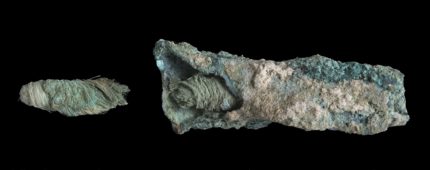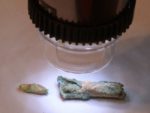Researchers at the Israel Antiquities Authority have uncovered a Byzantine-era lamp wick. At 1,500 years old, it is one of the oldest wicks of very few known to have survived. It was found at the ancient Byzantine site of Shivta south of Be’er Sheva, the flax material preserved by the arid climate of the Negev desert.

The wick was unearthed 85 years ago by American archaeologist Harris Dunscombe Colt who excavated Shivta in 1933-34. The ruins were first recorded in the 1860s and Leonard Woolley and his assistant T.E. Lawrence took detailed plans of the site in 1914-15, but Colt’s expedition was the first systematic archaeological exploration of the site. The city has elements of  Nabatean influence, primarily their characteristic desert management irrigation and agricultural techniques found at a farm next to the urban site. Aside from a few 1st century B.C. Roman structures, the archaeological remains in the city itself — churches, wine presses, homes, government buildings — are Byzantine.
Nabatean influence, primarily their characteristic desert management irrigation and agricultural techniques found at a farm next to the urban site. Aside from a few 1st century B.C. Roman structures, the archaeological remains in the city itself — churches, wine presses, homes, government buildings — are Byzantine.
Only a brief report on the Shivta dig in the 1935 issue of Palestine Exploration Fund Quarterly was ever published. The artifacts are now being studied for the first time as part of the Negev Byzantine Bio-Archaeology Research Program, a comprehensive examination of Byzantine settlements in the Negev led by University of Haifa professors. The wick was sent to the Israel Antiquities Authority laboratory for analysis last year.
Dr. Naama Sukenik of the Israel Antiquities Authority, who studied the wick says: “It seems that this rare find was preserved thanks to the dry climate in the Negev. Oil lamps played a key role in daily life in antiquity, illuminating homes and public buildings after sunset. Lamps made of pottery or glass are often found in archaeological excavations, but to find a wick from ancient times is rare. That’s because they’re made of organic fibers, which normally disintegrate quickly and disappear into the soil, as well as because they are so small and are usually consumed by fire.”
The wick was found in its holder – a small copper tube in which it was inserted when it was lit. Microscopic examination by Dr. Sukenik showed that the wick was made of linen, which comes from the flax plant and is known for its use in textiles and clothing as well as for wicks in oil lamps.
“The Mishnah [, the main book of Jewish legal theory], tractate Shabbat discusses what materials may and may not be used as wicks to light Sabbath lamps. There too, linen is mentioned as a high-quality material for wicks, because it burns long and beautifully. The Mishnah mentions other wicks, which were made of lesser quality materials and were therefore prohibited for use in Sabbath lamps. Among these were fibers made from the plant called Sodom’s apple, which to this day grows in the Dead Sea area. It seems that the inhabitants of Shivta also chose to light their public buildings with linen wicks. Because flax doesn’t grow in the Negev it probably came from farther north in the country through commerce,” Dr. Sukenik added.
 This wick was made of lower quality flax fibers. It was just a few centimeters long and meant to be consumed by fire, so might as well use the cheaper linen. The longer, more expensive fibers were saved for making clothes. It would have been used in a glass lamp, a simple cup or bowl filled with oil that was slurped up by the linen and provide fuel for the light.
This wick was made of lower quality flax fibers. It was just a few centimeters long and meant to be consumed by fire, so might as well use the cheaper linen. The longer, more expensive fibers were saved for making clothes. It would have been used in a glass lamp, a simple cup or bowl filled with oil that was slurped up by the linen and provide fuel for the light.
The wick in its bronze carrier and other artifacts unearthed by Colt and his team at Shivta will go on display at the Hecht Museum in Haifa staring January 24th, 2019.